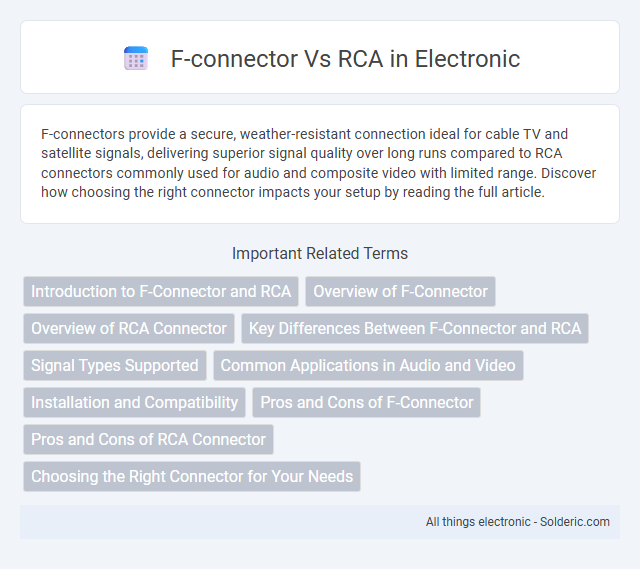F-connectors provide a secure, weather-resistant connection ideal for cable TV and satellite signals, delivering superior signal quality over long runs compared to RCA connectors commonly used for audio and composite video with limited range. Discover how choosing the right connector impacts your setup by reading the full article.
Comparison Table
| Feature | F-Connector | RCA Connector |
|---|---|---|
| Purpose | Coaxial cable connections, mainly for TV and satellite signals | Audio and video signal transmission, analog |
| Connection Type | Screw-on threaded connection | Push-in connection |
| Cable Compatibility | RG6, RG59 coaxial cables | Composite cables, RCA cables |
| Signal Type | RF (radio frequency), digital TV signals | Analog audio, analog video, composite video |
| Impedance | 75 ohms | Typically 50-75 ohms (varies) |
| Use Case | TV antenna, cable TV, satellite TV | Audio devices, stereo systems, older video devices |
| Durability | Robust, secure connection for RF signals | Less secure, prone to loose connections |
| Signal Quality | Better for high-frequency signals | Suitable for baseband analog signals |
Introduction to F-Connector and RCA
The F-connector is a coaxial cable connector primarily used for cable television, satellite, and broadband internet connections, known for its screw-type mechanism ensuring a secure, weather-resistant connection. RCA connectors, commonly found in audio and video equipment, utilize a simple push-in design ideal for analog signals but less effective for high-frequency transmissions. While F-connectors specialize in maintaining signal integrity over long distances with minimal interference, RCA connectors excel in ease of use and compatibility with consumer electronics.
Overview of F-Connector
F-Connectors are commonly used in cable television, satellite TV, and broadband internet connections due to their reliable screw-on design that ensures a secure, interference-resistant connection. They are ideal for transmitting high-frequency signals over coaxial cables, providing better signal quality for digital applications compared to RCA connectors. Your choice of an F-Connector supports efficient data transmission in modern home entertainment and communication systems.
Overview of RCA Connector
The RCA connector is a widely used audio and video interface characterized by its simple design featuring a central pin and an outer ring, primarily transmitting analog signals. Commonly found in home entertainment systems, RCA connectors support composite video, stereo audio, and component video connections, making them versatile for consumer electronics. Compared to F-connectors, which are predominantly used for cable television and satellite signals, RCA connectors offer straightforward plug-and-play functionality but lack the robustness for high-frequency transmissions.
Key Differences Between F-Connector and RCA
F-Connectors are primarily used for coaxial cable connections in satellite, cable TV, and broadband internet, providing low signal loss and secure, threaded connections, while RCA connectors are commonly used for analog audio and composite video signals with a simpler push-in design. F-Connectors support higher frequency signals, typically up to several gigahertz, making them ideal for RF applications, whereas RCA connectors operate at lower frequencies and are not suitable for high-frequency RF transmission. The distinct physical designs--F-Connectors with a screw-on mechanism versus RCA's pin and sleeve structure--affect their durability and signal integrity based on application requirements.
Signal Types Supported
F-connectors support coaxial cable signals primarily used for RF signals like cable TV, satellite, and broadband internet, ensuring high-frequency signal transmission with minimal interference. RCA connectors handle analog audio and composite video signals, making them suitable for connecting older AV equipment such as DVD players and stereo systems. Your choice between them depends on whether you need to transmit RF or analog audio/video signals for your setup.
Common Applications in Audio and Video
F-connectors are commonly used in cable television, satellite TV, and broadband internet connections due to their reliable signal transmission for RF (radio frequency) signals. RCA connectors dominate in stereo audio systems, home theater setups, and analog video devices such as DVD players and older gaming consoles, providing separate channels for audio and video signals. While F-connectors excel in high-frequency applications for digital signals, RCA connectors remain standard for analog audio and composite video connections.
Installation and Compatibility
F-connectors offer straightforward installation with a screw-on design ensuring a secure connection primarily used for coaxial cables in cable television and satellite systems. RCA connectors, featuring a simple plug-and-socket mechanism, are widely compatible with audio and composite video devices but may require adapters for modern digital equipment. Choosing between F-connector and RCA depends on the specific application, signal type, and device compatibility requirements.
Pros and Cons of F-Connector
F-connectors offer superior shielding and signal integrity, making them ideal for cable TV and satellite connections where minimizing interference is crucial. Their threaded design ensures a secure, reliable connection but can be more challenging to install compared to the push-in style RCA connectors. If your setup demands durable, high-frequency performance, choosing F-connectors enhances overall signal quality while requiring slightly more installation effort.
Pros and Cons of RCA Connector
RCA connectors offer easy installation and widespread compatibility with audio and video devices, making them ideal for standard consumer electronics. They, however, suffer from weaker signal quality and higher susceptibility to interference compared to F-connectors, which provide better shielding and secure connections for cable television and satellite signals. Your choice depends on whether convenience or signal integrity is the priority in your setup.
Choosing the Right Connector for Your Needs
F-connectors provide superior signal quality and are ideal for TV cable and satellite connections due to their threaded design, ensuring a secure and interference-resistant link. RCA connectors, commonly used for audio and composite video, offer easy plug-and-play convenience but may experience signal degradation over longer distances. Your choice depends on the specific application, with F-connectors suited for high-frequency transmissions and RCA connectors better for older or simpler audiovisual setups.
F-connector vs RCA Infographic

 solderic.com
solderic.com